Developing Cross-Cultural Capabilities: Barker Shoes Report
VerifiedAdded on 2022/12/28
|11
|3161
|89
Report
AI Summary
This report analyzes the development of cross-cultural capabilities within the context of Barker Shoes, a UK-based shoe manufacturer planning to expand its production to Vietnam. It begins with an overview of cross-cultural capabilities and their importance in the modern business environment, followed by a discussion of the opportunities and risks associated with a partial shift in manufacturing. The report then delves into two prominent cultural models: Hofstede's model, examining dimensions like power distance and individualism, and Trompenaar's model, exploring dimensions such as universalism versus particularism and neutral versus emotional cultures. The analysis highlights how these models can facilitate effective management of cross-cultural and human resource considerations, providing insights into potential challenges and strategies for successful international business operations. The report concludes with a summary of key findings and recommendations for Barker Shoes.
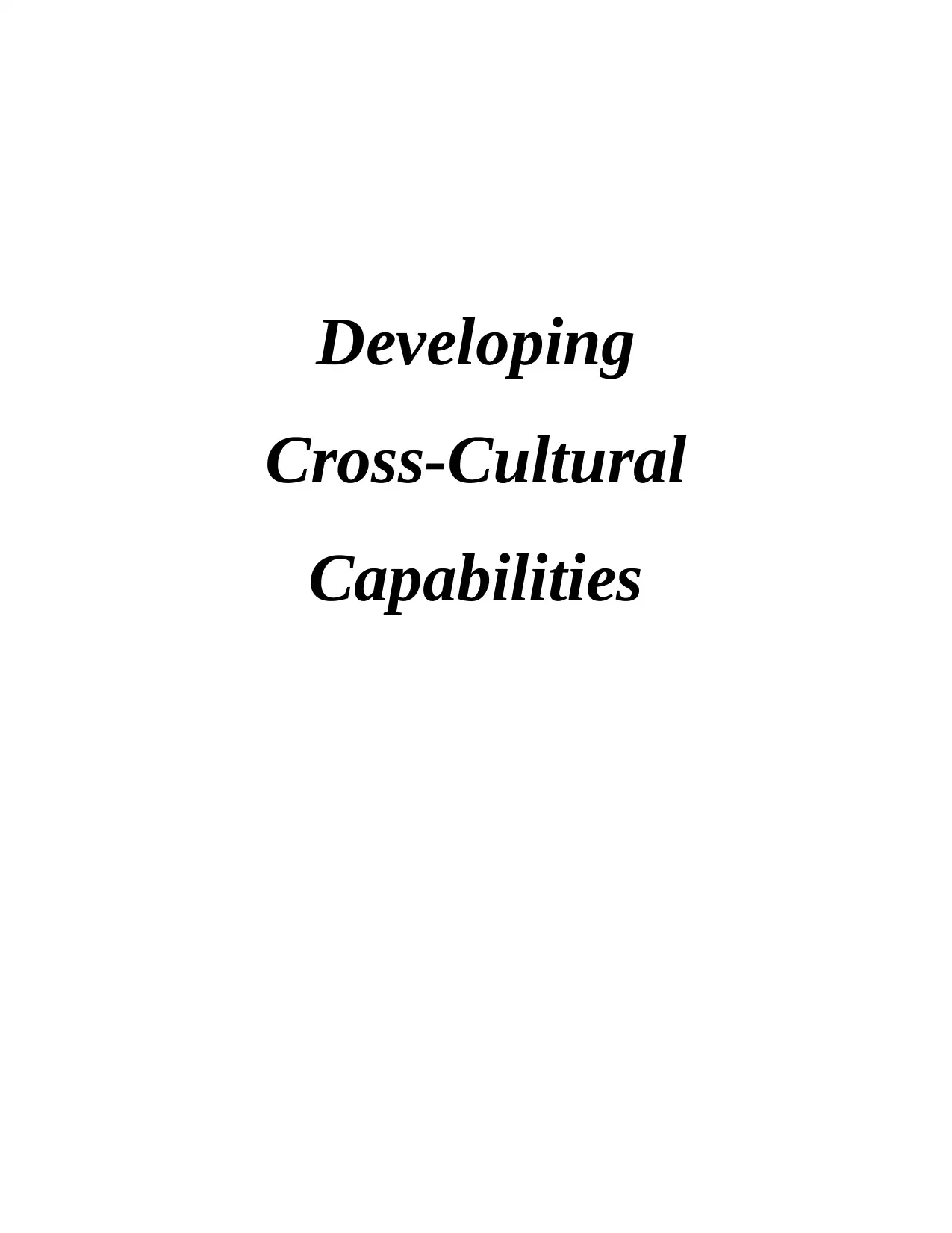
Developing
Cross-Cultural
Capabilities
Cross-Cultural
Capabilities
Paraphrase This Document
Need a fresh take? Get an instant paraphrase of this document with our AI Paraphraser
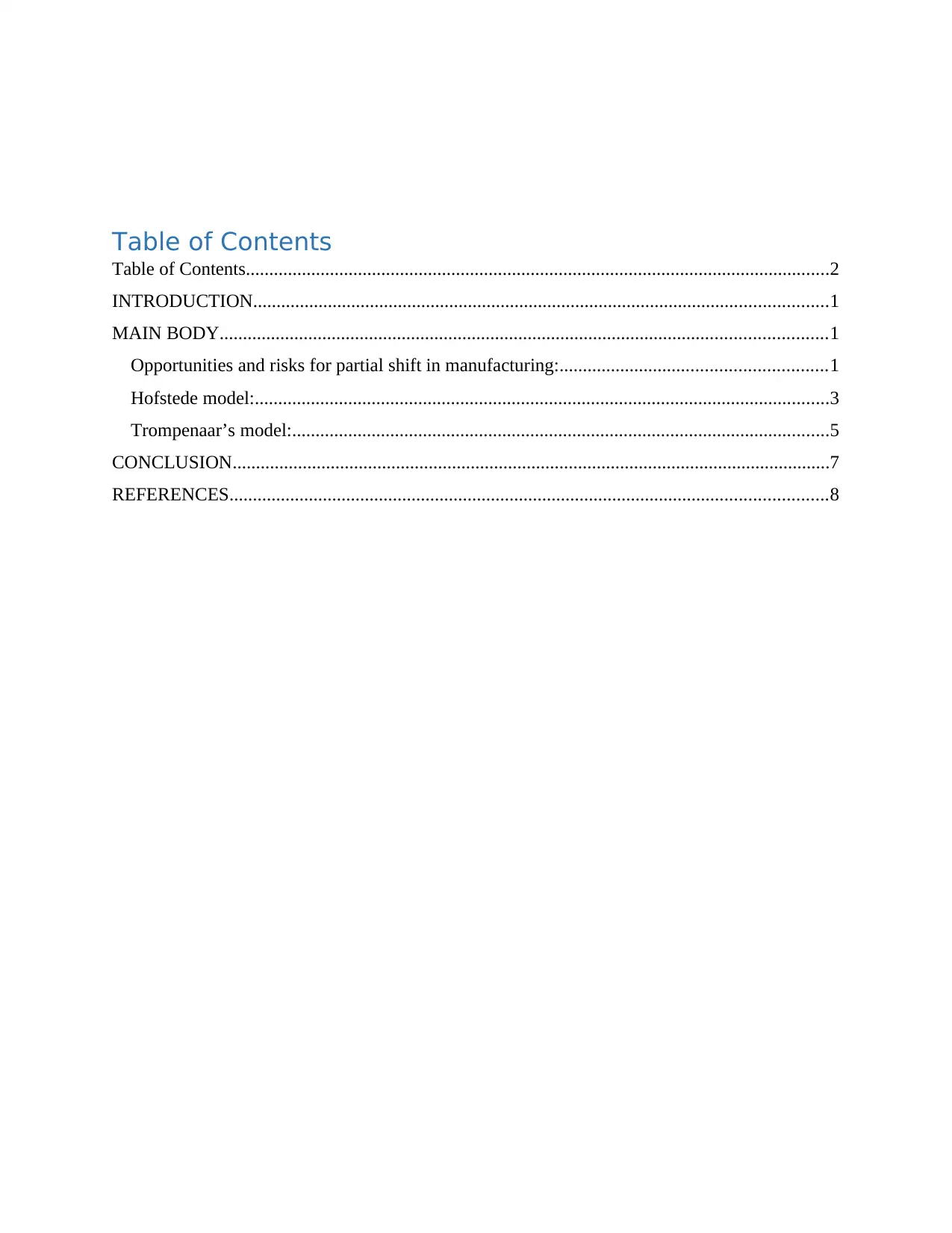
Table of Contents
Table of Contents.............................................................................................................................2
INTRODUCTION...........................................................................................................................1
MAIN BODY..................................................................................................................................1
Opportunities and risks for partial shift in manufacturing:.........................................................1
Hofstede model:...........................................................................................................................3
Trompenaar’s model:...................................................................................................................5
CONCLUSION................................................................................................................................7
REFERENCES................................................................................................................................8
Table of Contents.............................................................................................................................2
INTRODUCTION...........................................................................................................................1
MAIN BODY..................................................................................................................................1
Opportunities and risks for partial shift in manufacturing:.........................................................1
Hofstede model:...........................................................................................................................3
Trompenaar’s model:...................................................................................................................5
CONCLUSION................................................................................................................................7
REFERENCES................................................................................................................................8

⊘ This is a preview!⊘
Do you want full access?
Subscribe today to unlock all pages.

Trusted by 1+ million students worldwide
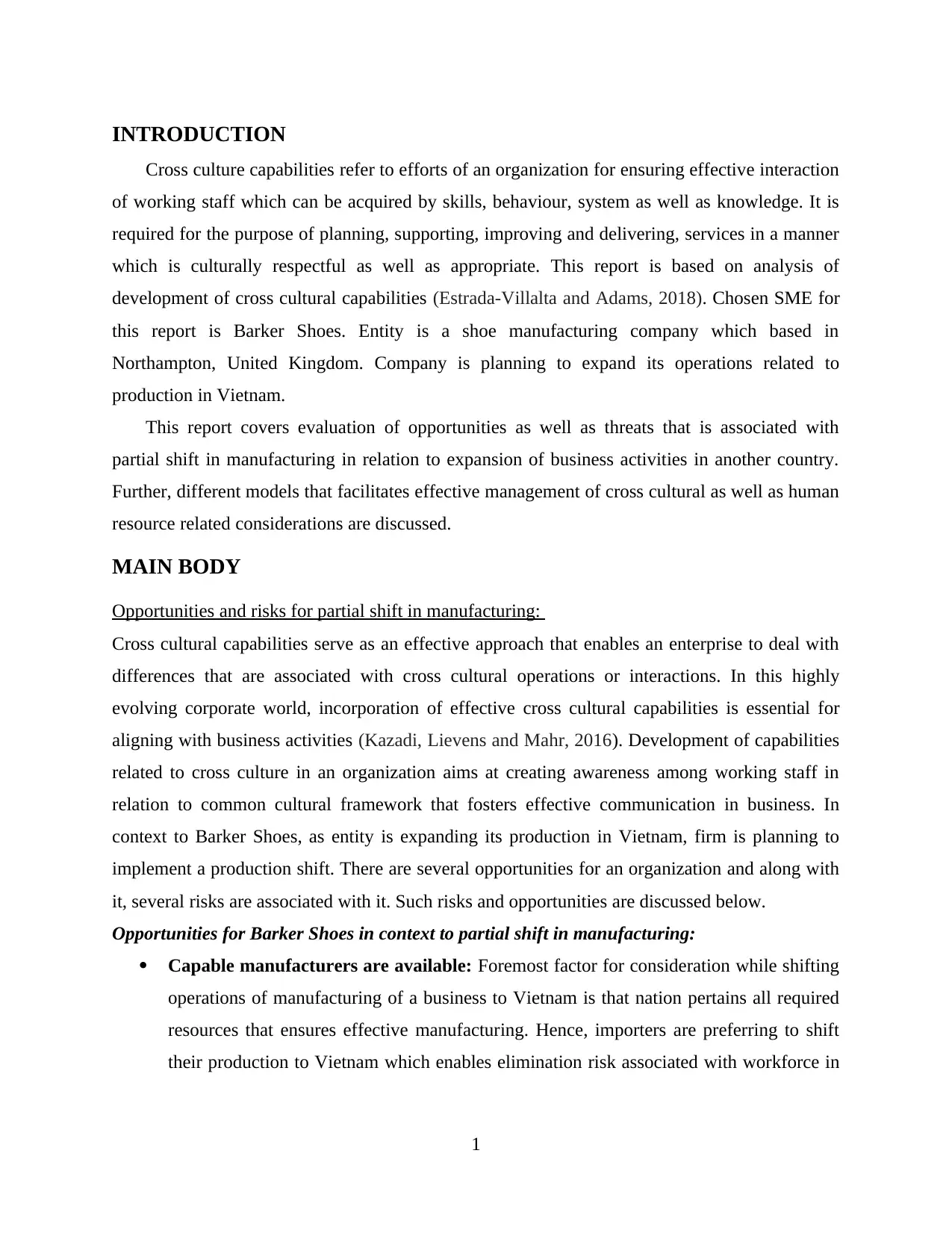
INTRODUCTION
Cross culture capabilities refer to efforts of an organization for ensuring effective interaction
of working staff which can be acquired by skills, behaviour, system as well as knowledge. It is
required for the purpose of planning, supporting, improving and delivering, services in a manner
which is culturally respectful as well as appropriate. This report is based on analysis of
development of cross cultural capabilities (Estrada-Villalta and Adams, 2018). Chosen SME for
this report is Barker Shoes. Entity is a shoe manufacturing company which based in
Northampton, United Kingdom. Company is planning to expand its operations related to
production in Vietnam.
This report covers evaluation of opportunities as well as threats that is associated with
partial shift in manufacturing in relation to expansion of business activities in another country.
Further, different models that facilitates effective management of cross cultural as well as human
resource related considerations are discussed.
MAIN BODY
Opportunities and risks for partial shift in manufacturing:
Cross cultural capabilities serve as an effective approach that enables an enterprise to deal with
differences that are associated with cross cultural operations or interactions. In this highly
evolving corporate world, incorporation of effective cross cultural capabilities is essential for
aligning with business activities (Kazadi, Lievens and Mahr, 2016). Development of capabilities
related to cross culture in an organization aims at creating awareness among working staff in
relation to common cultural framework that fosters effective communication in business. In
context to Barker Shoes, as entity is expanding its production in Vietnam, firm is planning to
implement a production shift. There are several opportunities for an organization and along with
it, several risks are associated with it. Such risks and opportunities are discussed below.
Opportunities for Barker Shoes in context to partial shift in manufacturing:
Capable manufacturers are available: Foremost factor for consideration while shifting
operations of manufacturing of a business to Vietnam is that nation pertains all required
resources that ensures effective manufacturing. Hence, importers are preferring to shift
their production to Vietnam which enables elimination risk associated with workforce in
1
Cross culture capabilities refer to efforts of an organization for ensuring effective interaction
of working staff which can be acquired by skills, behaviour, system as well as knowledge. It is
required for the purpose of planning, supporting, improving and delivering, services in a manner
which is culturally respectful as well as appropriate. This report is based on analysis of
development of cross cultural capabilities (Estrada-Villalta and Adams, 2018). Chosen SME for
this report is Barker Shoes. Entity is a shoe manufacturing company which based in
Northampton, United Kingdom. Company is planning to expand its operations related to
production in Vietnam.
This report covers evaluation of opportunities as well as threats that is associated with
partial shift in manufacturing in relation to expansion of business activities in another country.
Further, different models that facilitates effective management of cross cultural as well as human
resource related considerations are discussed.
MAIN BODY
Opportunities and risks for partial shift in manufacturing:
Cross cultural capabilities serve as an effective approach that enables an enterprise to deal with
differences that are associated with cross cultural operations or interactions. In this highly
evolving corporate world, incorporation of effective cross cultural capabilities is essential for
aligning with business activities (Kazadi, Lievens and Mahr, 2016). Development of capabilities
related to cross culture in an organization aims at creating awareness among working staff in
relation to common cultural framework that fosters effective communication in business. In
context to Barker Shoes, as entity is expanding its production in Vietnam, firm is planning to
implement a production shift. There are several opportunities for an organization and along with
it, several risks are associated with it. Such risks and opportunities are discussed below.
Opportunities for Barker Shoes in context to partial shift in manufacturing:
Capable manufacturers are available: Foremost factor for consideration while shifting
operations of manufacturing of a business to Vietnam is that nation pertains all required
resources that ensures effective manufacturing. Hence, importers are preferring to shift
their production to Vietnam which enables elimination risk associated with workforce in
1
Paraphrase This Document
Need a fresh take? Get an instant paraphrase of this document with our AI Paraphraser
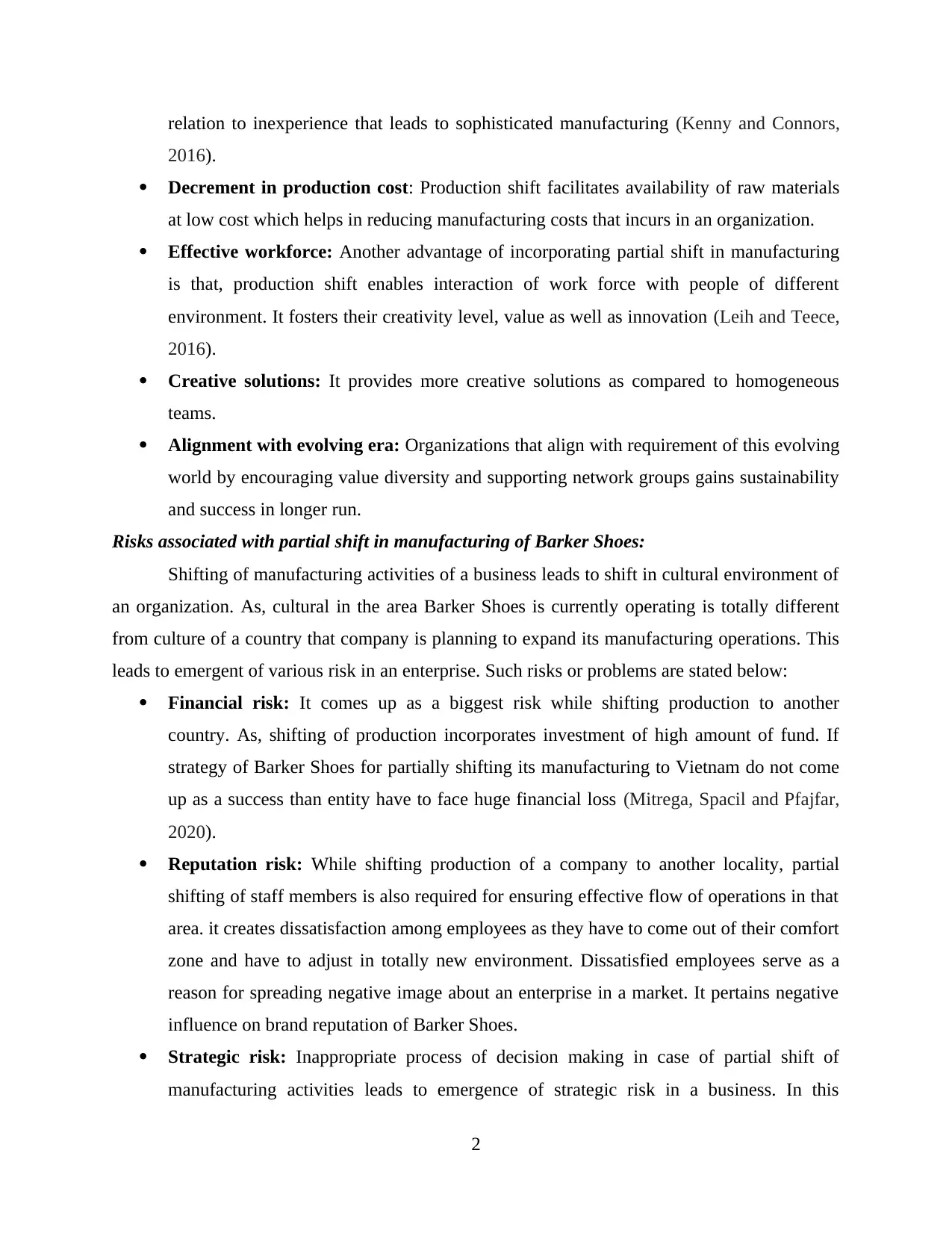
relation to inexperience that leads to sophisticated manufacturing (Kenny and Connors,
2016).
Decrement in production cost: Production shift facilitates availability of raw materials
at low cost which helps in reducing manufacturing costs that incurs in an organization.
Effective workforce: Another advantage of incorporating partial shift in manufacturing
is that, production shift enables interaction of work force with people of different
environment. It fosters their creativity level, value as well as innovation (Leih and Teece,
2016).
Creative solutions: It provides more creative solutions as compared to homogeneous
teams.
Alignment with evolving era: Organizations that align with requirement of this evolving
world by encouraging value diversity and supporting network groups gains sustainability
and success in longer run.
Risks associated with partial shift in manufacturing of Barker Shoes:
Shifting of manufacturing activities of a business leads to shift in cultural environment of
an organization. As, cultural in the area Barker Shoes is currently operating is totally different
from culture of a country that company is planning to expand its manufacturing operations. This
leads to emergent of various risk in an enterprise. Such risks or problems are stated below:
Financial risk: It comes up as a biggest risk while shifting production to another
country. As, shifting of production incorporates investment of high amount of fund. If
strategy of Barker Shoes for partially shifting its manufacturing to Vietnam do not come
up as a success than entity have to face huge financial loss (Mitrega, Spacil and Pfajfar,
2020).
Reputation risk: While shifting production of a company to another locality, partial
shifting of staff members is also required for ensuring effective flow of operations in that
area. it creates dissatisfaction among employees as they have to come out of their comfort
zone and have to adjust in totally new environment. Dissatisfied employees serve as a
reason for spreading negative image about an enterprise in a market. It pertains negative
influence on brand reputation of Barker Shoes.
Strategic risk: Inappropriate process of decision making in case of partial shift of
manufacturing activities leads to emergence of strategic risk in a business. In this
2
2016).
Decrement in production cost: Production shift facilitates availability of raw materials
at low cost which helps in reducing manufacturing costs that incurs in an organization.
Effective workforce: Another advantage of incorporating partial shift in manufacturing
is that, production shift enables interaction of work force with people of different
environment. It fosters their creativity level, value as well as innovation (Leih and Teece,
2016).
Creative solutions: It provides more creative solutions as compared to homogeneous
teams.
Alignment with evolving era: Organizations that align with requirement of this evolving
world by encouraging value diversity and supporting network groups gains sustainability
and success in longer run.
Risks associated with partial shift in manufacturing of Barker Shoes:
Shifting of manufacturing activities of a business leads to shift in cultural environment of
an organization. As, cultural in the area Barker Shoes is currently operating is totally different
from culture of a country that company is planning to expand its manufacturing operations. This
leads to emergent of various risk in an enterprise. Such risks or problems are stated below:
Financial risk: It comes up as a biggest risk while shifting production to another
country. As, shifting of production incorporates investment of high amount of fund. If
strategy of Barker Shoes for partially shifting its manufacturing to Vietnam do not come
up as a success than entity have to face huge financial loss (Mitrega, Spacil and Pfajfar,
2020).
Reputation risk: While shifting production of a company to another locality, partial
shifting of staff members is also required for ensuring effective flow of operations in that
area. it creates dissatisfaction among employees as they have to come out of their comfort
zone and have to adjust in totally new environment. Dissatisfied employees serve as a
reason for spreading negative image about an enterprise in a market. It pertains negative
influence on brand reputation of Barker Shoes.
Strategic risk: Inappropriate process of decision making in case of partial shift of
manufacturing activities leads to emergence of strategic risk in a business. In this
2
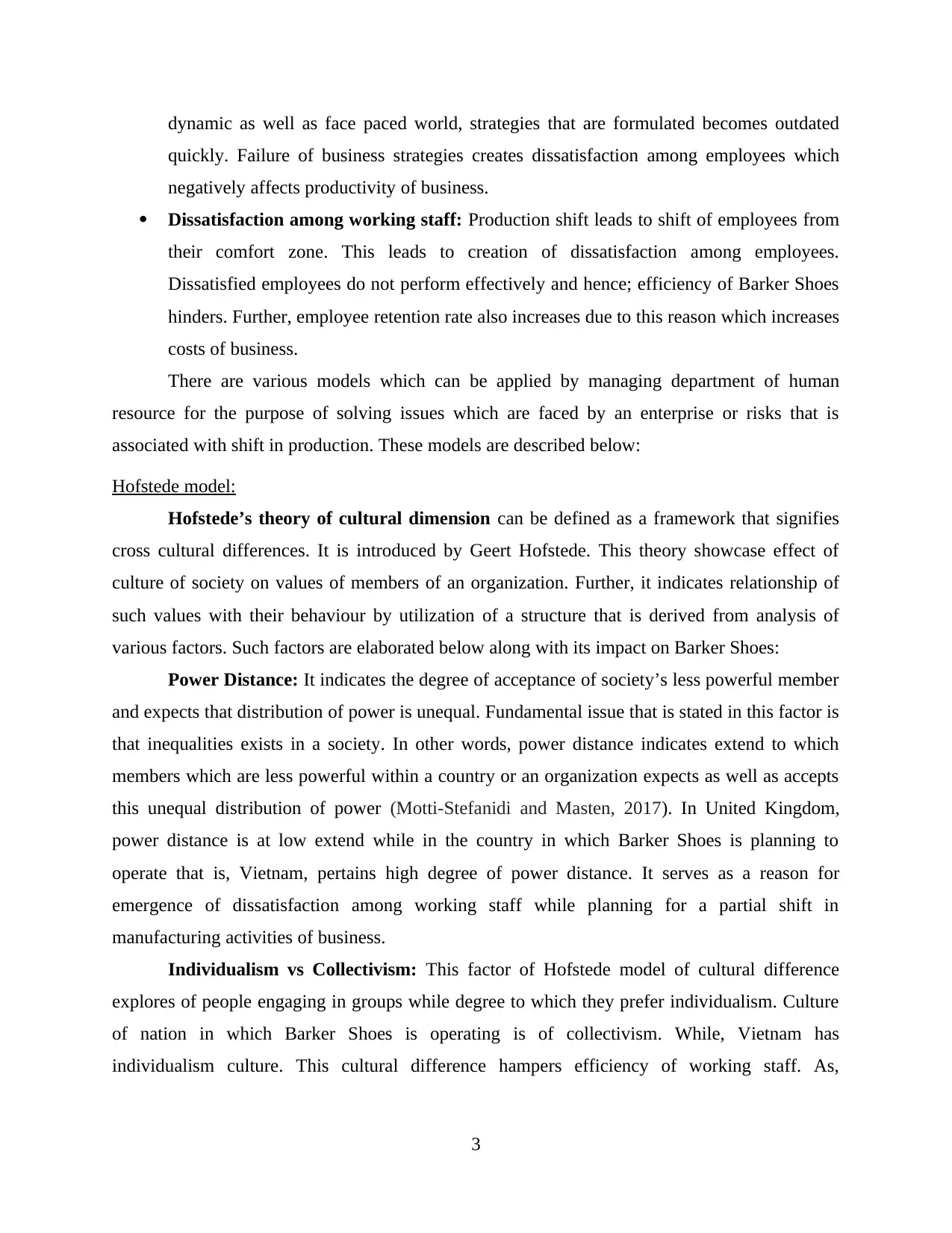
dynamic as well as face paced world, strategies that are formulated becomes outdated
quickly. Failure of business strategies creates dissatisfaction among employees which
negatively affects productivity of business.
Dissatisfaction among working staff: Production shift leads to shift of employees from
their comfort zone. This leads to creation of dissatisfaction among employees.
Dissatisfied employees do not perform effectively and hence; efficiency of Barker Shoes
hinders. Further, employee retention rate also increases due to this reason which increases
costs of business.
There are various models which can be applied by managing department of human
resource for the purpose of solving issues which are faced by an enterprise or risks that is
associated with shift in production. These models are described below:
Hofstede model:
Hofstede’s theory of cultural dimension can be defined as a framework that signifies
cross cultural differences. It is introduced by Geert Hofstede. This theory showcase effect of
culture of society on values of members of an organization. Further, it indicates relationship of
such values with their behaviour by utilization of a structure that is derived from analysis of
various factors. Such factors are elaborated below along with its impact on Barker Shoes:
Power Distance: It indicates the degree of acceptance of society’s less powerful member
and expects that distribution of power is unequal. Fundamental issue that is stated in this factor is
that inequalities exists in a society. In other words, power distance indicates extend to which
members which are less powerful within a country or an organization expects as well as accepts
this unequal distribution of power (Motti-Stefanidi and Masten, 2017). In United Kingdom,
power distance is at low extend while in the country in which Barker Shoes is planning to
operate that is, Vietnam, pertains high degree of power distance. It serves as a reason for
emergence of dissatisfaction among working staff while planning for a partial shift in
manufacturing activities of business.
Individualism vs Collectivism: This factor of Hofstede model of cultural difference
explores of people engaging in groups while degree to which they prefer individualism. Culture
of nation in which Barker Shoes is operating is of collectivism. While, Vietnam has
individualism culture. This cultural difference hampers efficiency of working staff. As,
3
quickly. Failure of business strategies creates dissatisfaction among employees which
negatively affects productivity of business.
Dissatisfaction among working staff: Production shift leads to shift of employees from
their comfort zone. This leads to creation of dissatisfaction among employees.
Dissatisfied employees do not perform effectively and hence; efficiency of Barker Shoes
hinders. Further, employee retention rate also increases due to this reason which increases
costs of business.
There are various models which can be applied by managing department of human
resource for the purpose of solving issues which are faced by an enterprise or risks that is
associated with shift in production. These models are described below:
Hofstede model:
Hofstede’s theory of cultural dimension can be defined as a framework that signifies
cross cultural differences. It is introduced by Geert Hofstede. This theory showcase effect of
culture of society on values of members of an organization. Further, it indicates relationship of
such values with their behaviour by utilization of a structure that is derived from analysis of
various factors. Such factors are elaborated below along with its impact on Barker Shoes:
Power Distance: It indicates the degree of acceptance of society’s less powerful member
and expects that distribution of power is unequal. Fundamental issue that is stated in this factor is
that inequalities exists in a society. In other words, power distance indicates extend to which
members which are less powerful within a country or an organization expects as well as accepts
this unequal distribution of power (Motti-Stefanidi and Masten, 2017). In United Kingdom,
power distance is at low extend while in the country in which Barker Shoes is planning to
operate that is, Vietnam, pertains high degree of power distance. It serves as a reason for
emergence of dissatisfaction among working staff while planning for a partial shift in
manufacturing activities of business.
Individualism vs Collectivism: This factor of Hofstede model of cultural difference
explores of people engaging in groups while degree to which they prefer individualism. Culture
of nation in which Barker Shoes is operating is of collectivism. While, Vietnam has
individualism culture. This cultural difference hampers efficiency of working staff. As,
3
⊘ This is a preview!⊘
Do you want full access?
Subscribe today to unlock all pages.

Trusted by 1+ million students worldwide
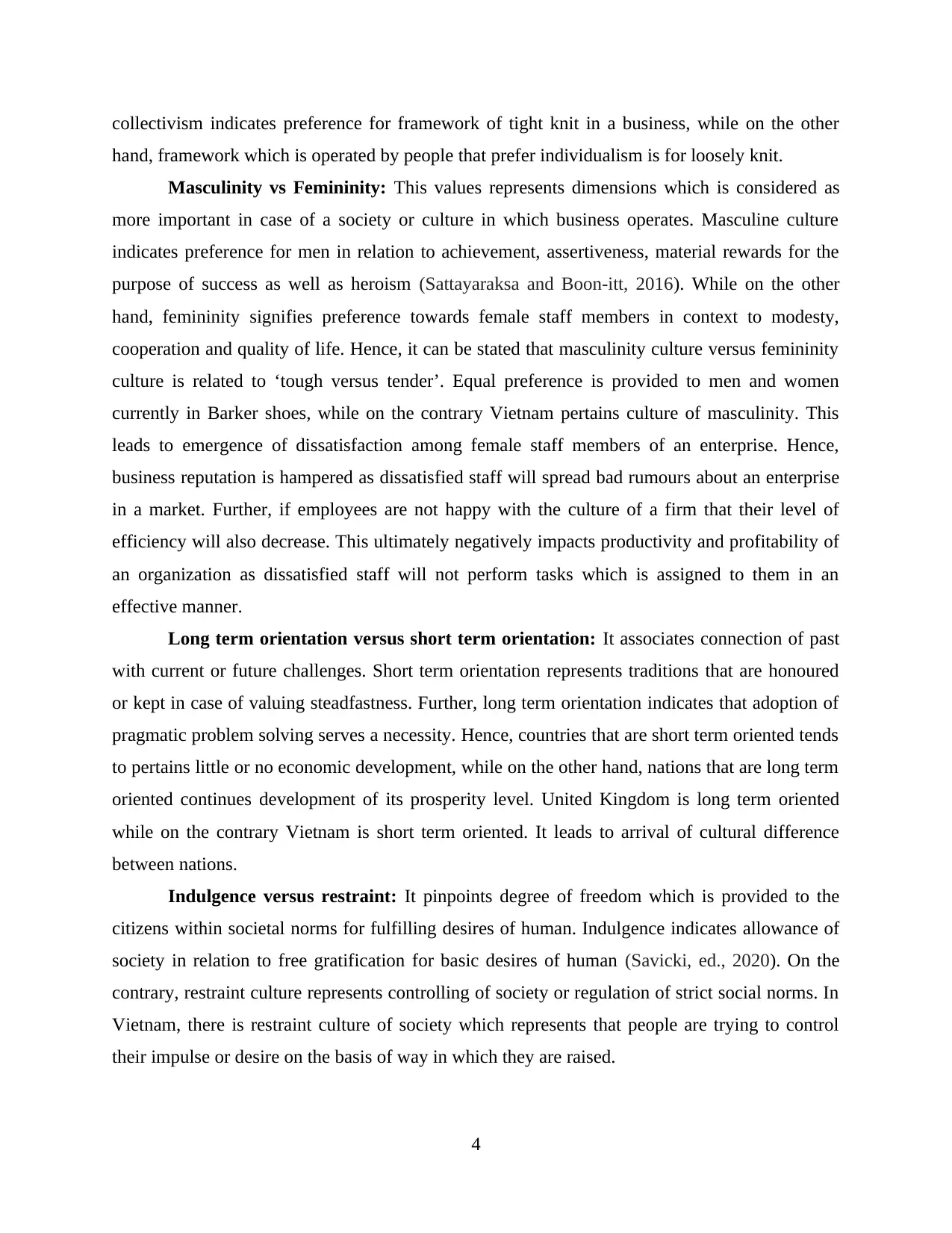
collectivism indicates preference for framework of tight knit in a business, while on the other
hand, framework which is operated by people that prefer individualism is for loosely knit.
Masculinity vs Femininity: This values represents dimensions which is considered as
more important in case of a society or culture in which business operates. Masculine culture
indicates preference for men in relation to achievement, assertiveness, material rewards for the
purpose of success as well as heroism (Sattayaraksa and Boon-itt, 2016). While on the other
hand, femininity signifies preference towards female staff members in context to modesty,
cooperation and quality of life. Hence, it can be stated that masculinity culture versus femininity
culture is related to ‘tough versus tender’. Equal preference is provided to men and women
currently in Barker shoes, while on the contrary Vietnam pertains culture of masculinity. This
leads to emergence of dissatisfaction among female staff members of an enterprise. Hence,
business reputation is hampered as dissatisfied staff will spread bad rumours about an enterprise
in a market. Further, if employees are not happy with the culture of a firm that their level of
efficiency will also decrease. This ultimately negatively impacts productivity and profitability of
an organization as dissatisfied staff will not perform tasks which is assigned to them in an
effective manner.
Long term orientation versus short term orientation: It associates connection of past
with current or future challenges. Short term orientation represents traditions that are honoured
or kept in case of valuing steadfastness. Further, long term orientation indicates that adoption of
pragmatic problem solving serves a necessity. Hence, countries that are short term oriented tends
to pertains little or no economic development, while on the other hand, nations that are long term
oriented continues development of its prosperity level. United Kingdom is long term oriented
while on the contrary Vietnam is short term oriented. It leads to arrival of cultural difference
between nations.
Indulgence versus restraint: It pinpoints degree of freedom which is provided to the
citizens within societal norms for fulfilling desires of human. Indulgence indicates allowance of
society in relation to free gratification for basic desires of human (Savicki, ed., 2020). On the
contrary, restraint culture represents controlling of society or regulation of strict social norms. In
Vietnam, there is restraint culture of society which represents that people are trying to control
their impulse or desire on the basis of way in which they are raised.
4
hand, framework which is operated by people that prefer individualism is for loosely knit.
Masculinity vs Femininity: This values represents dimensions which is considered as
more important in case of a society or culture in which business operates. Masculine culture
indicates preference for men in relation to achievement, assertiveness, material rewards for the
purpose of success as well as heroism (Sattayaraksa and Boon-itt, 2016). While on the other
hand, femininity signifies preference towards female staff members in context to modesty,
cooperation and quality of life. Hence, it can be stated that masculinity culture versus femininity
culture is related to ‘tough versus tender’. Equal preference is provided to men and women
currently in Barker shoes, while on the contrary Vietnam pertains culture of masculinity. This
leads to emergence of dissatisfaction among female staff members of an enterprise. Hence,
business reputation is hampered as dissatisfied staff will spread bad rumours about an enterprise
in a market. Further, if employees are not happy with the culture of a firm that their level of
efficiency will also decrease. This ultimately negatively impacts productivity and profitability of
an organization as dissatisfied staff will not perform tasks which is assigned to them in an
effective manner.
Long term orientation versus short term orientation: It associates connection of past
with current or future challenges. Short term orientation represents traditions that are honoured
or kept in case of valuing steadfastness. Further, long term orientation indicates that adoption of
pragmatic problem solving serves a necessity. Hence, countries that are short term oriented tends
to pertains little or no economic development, while on the other hand, nations that are long term
oriented continues development of its prosperity level. United Kingdom is long term oriented
while on the contrary Vietnam is short term oriented. It leads to arrival of cultural difference
between nations.
Indulgence versus restraint: It pinpoints degree of freedom which is provided to the
citizens within societal norms for fulfilling desires of human. Indulgence indicates allowance of
society in relation to free gratification for basic desires of human (Savicki, ed., 2020). On the
contrary, restraint culture represents controlling of society or regulation of strict social norms. In
Vietnam, there is restraint culture of society which represents that people are trying to control
their impulse or desire on the basis of way in which they are raised.
4
Paraphrase This Document
Need a fresh take? Get an instant paraphrase of this document with our AI Paraphraser
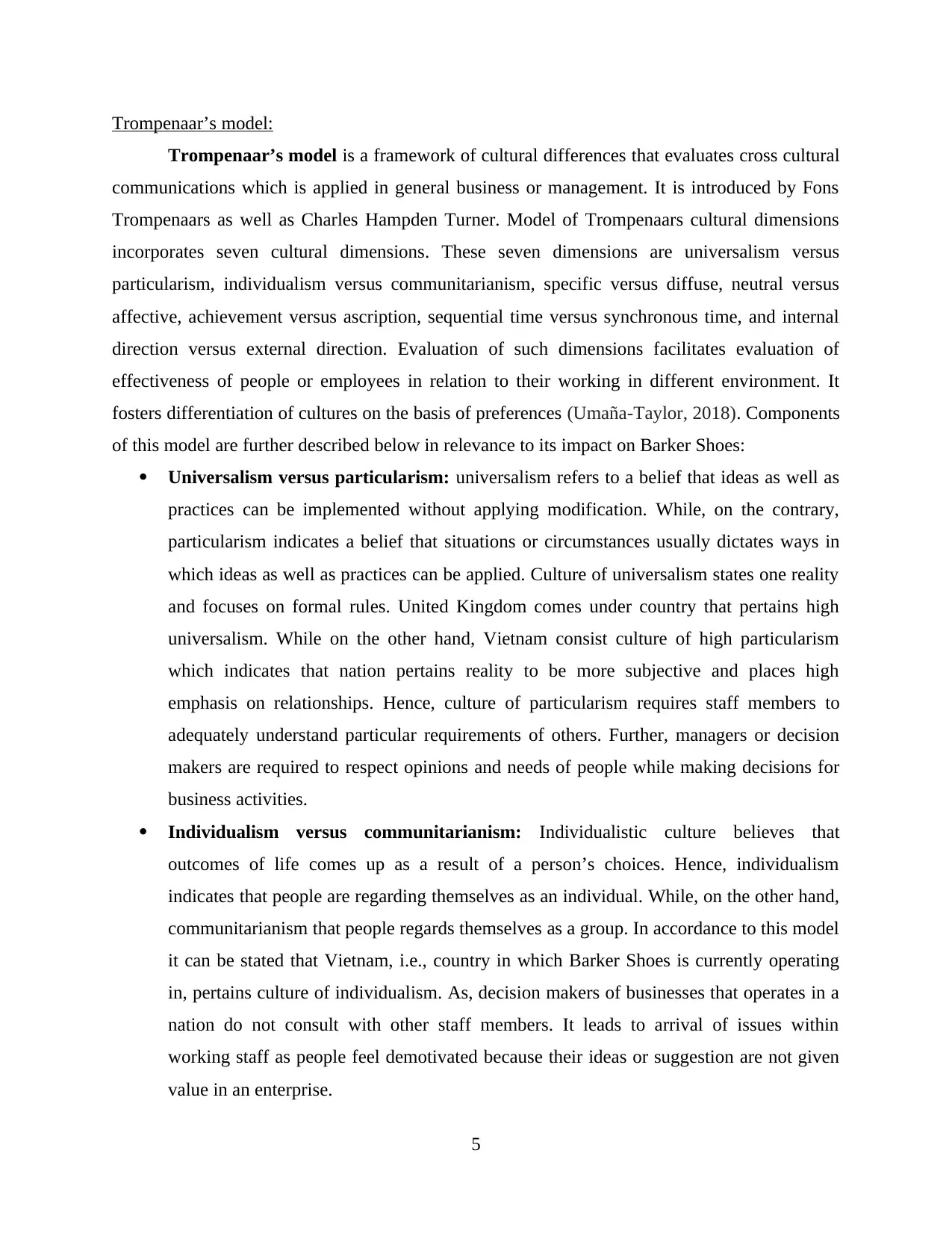
Trompenaar’s model:
Trompenaar’s model is a framework of cultural differences that evaluates cross cultural
communications which is applied in general business or management. It is introduced by Fons
Trompenaars as well as Charles Hampden Turner. Model of Trompenaars cultural dimensions
incorporates seven cultural dimensions. These seven dimensions are universalism versus
particularism, individualism versus communitarianism, specific versus diffuse, neutral versus
affective, achievement versus ascription, sequential time versus synchronous time, and internal
direction versus external direction. Evaluation of such dimensions facilitates evaluation of
effectiveness of people or employees in relation to their working in different environment. It
fosters differentiation of cultures on the basis of preferences (Umaña-Taylor, 2018). Components
of this model are further described below in relevance to its impact on Barker Shoes:
Universalism versus particularism: universalism refers to a belief that ideas as well as
practices can be implemented without applying modification. While, on the contrary,
particularism indicates a belief that situations or circumstances usually dictates ways in
which ideas as well as practices can be applied. Culture of universalism states one reality
and focuses on formal rules. United Kingdom comes under country that pertains high
universalism. While on the other hand, Vietnam consist culture of high particularism
which indicates that nation pertains reality to be more subjective and places high
emphasis on relationships. Hence, culture of particularism requires staff members to
adequately understand particular requirements of others. Further, managers or decision
makers are required to respect opinions and needs of people while making decisions for
business activities.
Individualism versus communitarianism: Individualistic culture believes that
outcomes of life comes up as a result of a person’s choices. Hence, individualism
indicates that people are regarding themselves as an individual. While, on the other hand,
communitarianism that people regards themselves as a group. In accordance to this model
it can be stated that Vietnam, i.e., country in which Barker Shoes is currently operating
in, pertains culture of individualism. As, decision makers of businesses that operates in a
nation do not consult with other staff members. It leads to arrival of issues within
working staff as people feel demotivated because their ideas or suggestion are not given
value in an enterprise.
5
Trompenaar’s model is a framework of cultural differences that evaluates cross cultural
communications which is applied in general business or management. It is introduced by Fons
Trompenaars as well as Charles Hampden Turner. Model of Trompenaars cultural dimensions
incorporates seven cultural dimensions. These seven dimensions are universalism versus
particularism, individualism versus communitarianism, specific versus diffuse, neutral versus
affective, achievement versus ascription, sequential time versus synchronous time, and internal
direction versus external direction. Evaluation of such dimensions facilitates evaluation of
effectiveness of people or employees in relation to their working in different environment. It
fosters differentiation of cultures on the basis of preferences (Umaña-Taylor, 2018). Components
of this model are further described below in relevance to its impact on Barker Shoes:
Universalism versus particularism: universalism refers to a belief that ideas as well as
practices can be implemented without applying modification. While, on the contrary,
particularism indicates a belief that situations or circumstances usually dictates ways in
which ideas as well as practices can be applied. Culture of universalism states one reality
and focuses on formal rules. United Kingdom comes under country that pertains high
universalism. While on the other hand, Vietnam consist culture of high particularism
which indicates that nation pertains reality to be more subjective and places high
emphasis on relationships. Hence, culture of particularism requires staff members to
adequately understand particular requirements of others. Further, managers or decision
makers are required to respect opinions and needs of people while making decisions for
business activities.
Individualism versus communitarianism: Individualistic culture believes that
outcomes of life comes up as a result of a person’s choices. Hence, individualism
indicates that people are regarding themselves as an individual. While, on the other hand,
communitarianism that people regards themselves as a group. In accordance to this model
it can be stated that Vietnam, i.e., country in which Barker Shoes is currently operating
in, pertains culture of individualism. As, decision makers of businesses that operates in a
nation do not consult with other staff members. It leads to arrival of issues within
working staff as people feel demotivated because their ideas or suggestion are not given
value in an enterprise.
5
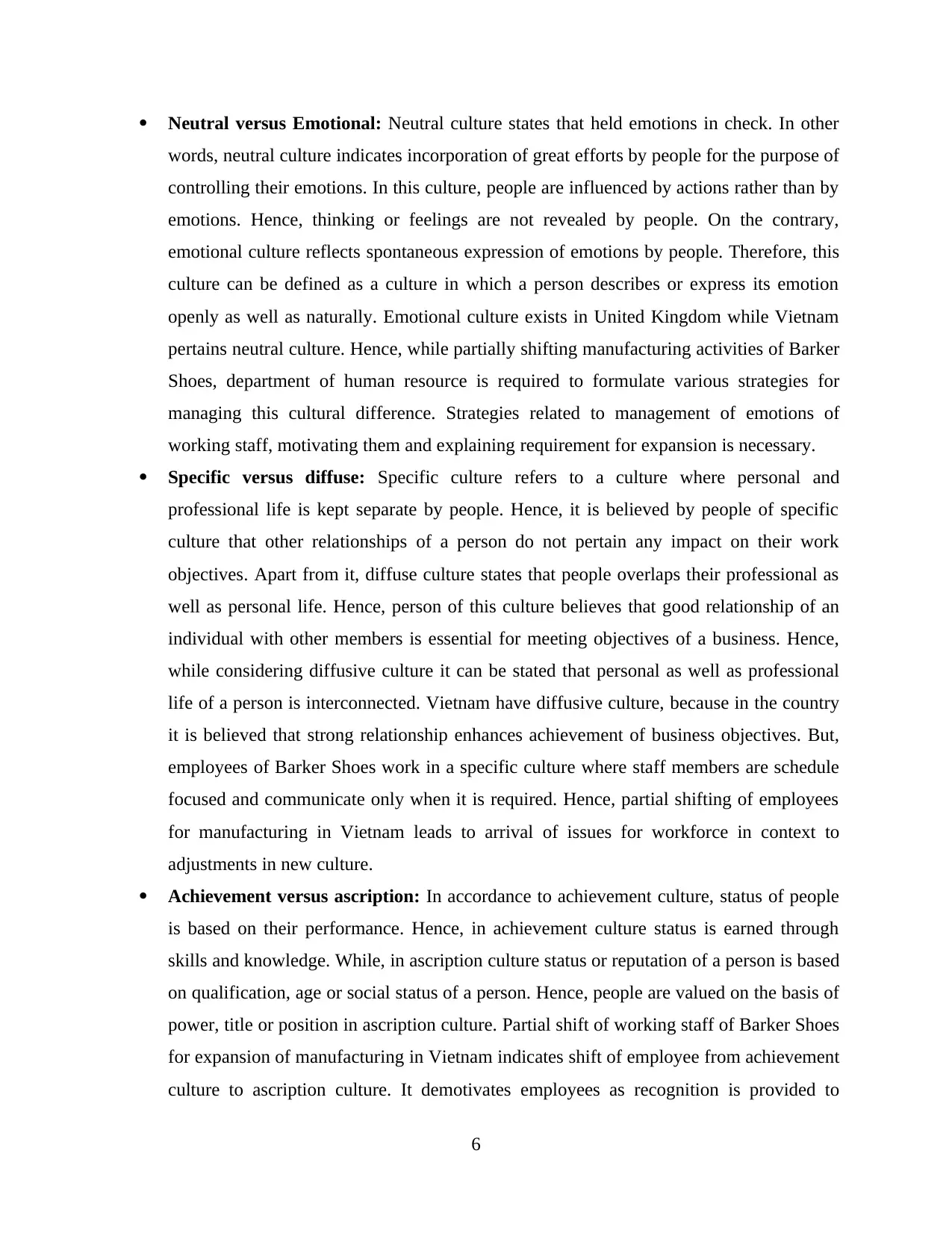
Neutral versus Emotional: Neutral culture states that held emotions in check. In other
words, neutral culture indicates incorporation of great efforts by people for the purpose of
controlling their emotions. In this culture, people are influenced by actions rather than by
emotions. Hence, thinking or feelings are not revealed by people. On the contrary,
emotional culture reflects spontaneous expression of emotions by people. Therefore, this
culture can be defined as a culture in which a person describes or express its emotion
openly as well as naturally. Emotional culture exists in United Kingdom while Vietnam
pertains neutral culture. Hence, while partially shifting manufacturing activities of Barker
Shoes, department of human resource is required to formulate various strategies for
managing this cultural difference. Strategies related to management of emotions of
working staff, motivating them and explaining requirement for expansion is necessary.
Specific versus diffuse: Specific culture refers to a culture where personal and
professional life is kept separate by people. Hence, it is believed by people of specific
culture that other relationships of a person do not pertain any impact on their work
objectives. Apart from it, diffuse culture states that people overlaps their professional as
well as personal life. Hence, person of this culture believes that good relationship of an
individual with other members is essential for meeting objectives of a business. Hence,
while considering diffusive culture it can be stated that personal as well as professional
life of a person is interconnected. Vietnam have diffusive culture, because in the country
it is believed that strong relationship enhances achievement of business objectives. But,
employees of Barker Shoes work in a specific culture where staff members are schedule
focused and communicate only when it is required. Hence, partial shifting of employees
for manufacturing in Vietnam leads to arrival of issues for workforce in context to
adjustments in new culture.
Achievement versus ascription: In accordance to achievement culture, status of people
is based on their performance. Hence, in achievement culture status is earned through
skills and knowledge. While, in ascription culture status or reputation of a person is based
on qualification, age or social status of a person. Hence, people are valued on the basis of
power, title or position in ascription culture. Partial shift of working staff of Barker Shoes
for expansion of manufacturing in Vietnam indicates shift of employee from achievement
culture to ascription culture. It demotivates employees as recognition is provided to
6
words, neutral culture indicates incorporation of great efforts by people for the purpose of
controlling their emotions. In this culture, people are influenced by actions rather than by
emotions. Hence, thinking or feelings are not revealed by people. On the contrary,
emotional culture reflects spontaneous expression of emotions by people. Therefore, this
culture can be defined as a culture in which a person describes or express its emotion
openly as well as naturally. Emotional culture exists in United Kingdom while Vietnam
pertains neutral culture. Hence, while partially shifting manufacturing activities of Barker
Shoes, department of human resource is required to formulate various strategies for
managing this cultural difference. Strategies related to management of emotions of
working staff, motivating them and explaining requirement for expansion is necessary.
Specific versus diffuse: Specific culture refers to a culture where personal and
professional life is kept separate by people. Hence, it is believed by people of specific
culture that other relationships of a person do not pertain any impact on their work
objectives. Apart from it, diffuse culture states that people overlaps their professional as
well as personal life. Hence, person of this culture believes that good relationship of an
individual with other members is essential for meeting objectives of a business. Hence,
while considering diffusive culture it can be stated that personal as well as professional
life of a person is interconnected. Vietnam have diffusive culture, because in the country
it is believed that strong relationship enhances achievement of business objectives. But,
employees of Barker Shoes work in a specific culture where staff members are schedule
focused and communicate only when it is required. Hence, partial shifting of employees
for manufacturing in Vietnam leads to arrival of issues for workforce in context to
adjustments in new culture.
Achievement versus ascription: In accordance to achievement culture, status of people
is based on their performance. Hence, in achievement culture status is earned through
skills and knowledge. While, in ascription culture status or reputation of a person is based
on qualification, age or social status of a person. Hence, people are valued on the basis of
power, title or position in ascription culture. Partial shift of working staff of Barker Shoes
for expansion of manufacturing in Vietnam indicates shift of employee from achievement
culture to ascription culture. It demotivates employees as recognition is provided to
6
⊘ This is a preview!⊘
Do you want full access?
Subscribe today to unlock all pages.

Trusted by 1+ million students worldwide
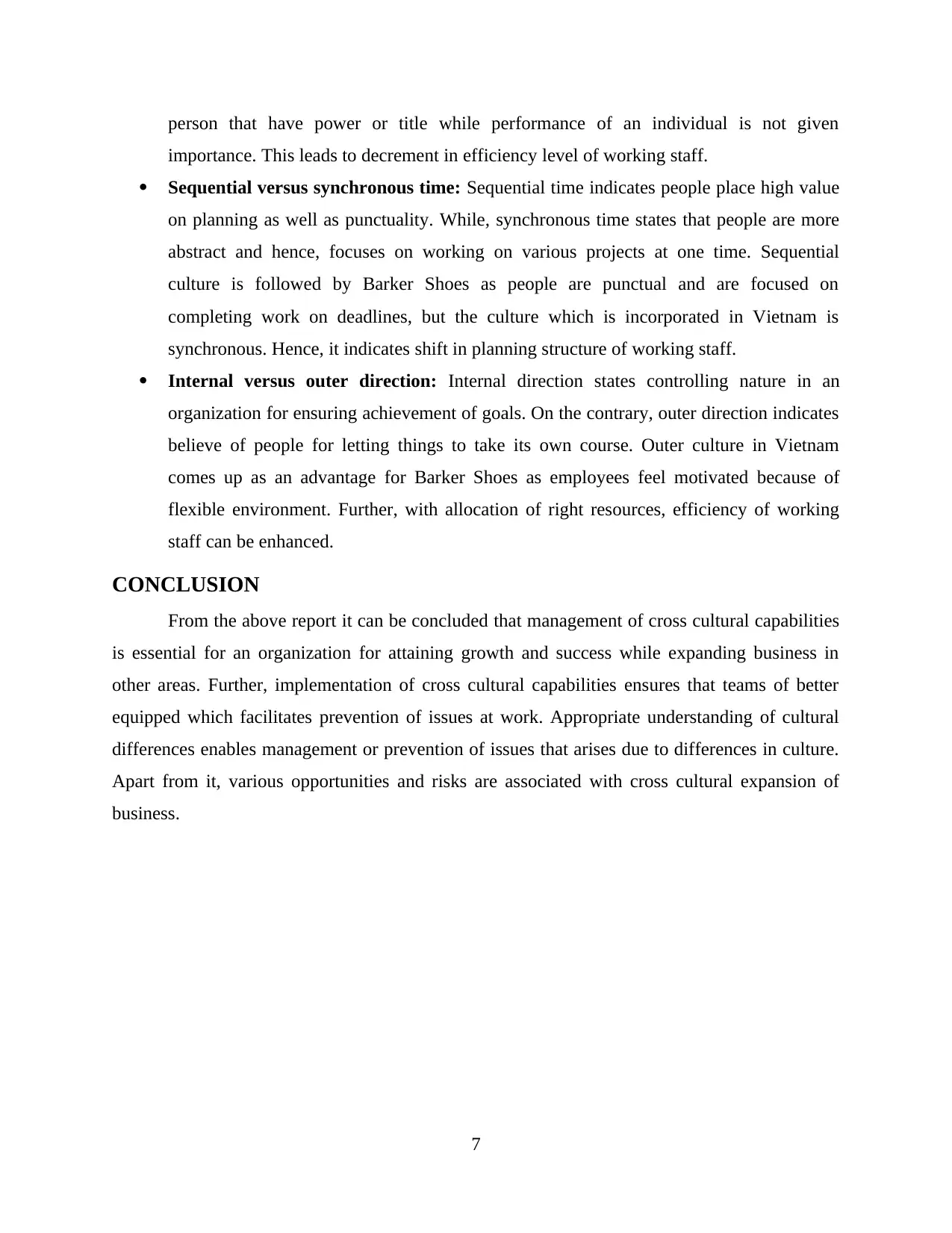
person that have power or title while performance of an individual is not given
importance. This leads to decrement in efficiency level of working staff.
Sequential versus synchronous time: Sequential time indicates people place high value
on planning as well as punctuality. While, synchronous time states that people are more
abstract and hence, focuses on working on various projects at one time. Sequential
culture is followed by Barker Shoes as people are punctual and are focused on
completing work on deadlines, but the culture which is incorporated in Vietnam is
synchronous. Hence, it indicates shift in planning structure of working staff.
Internal versus outer direction: Internal direction states controlling nature in an
organization for ensuring achievement of goals. On the contrary, outer direction indicates
believe of people for letting things to take its own course. Outer culture in Vietnam
comes up as an advantage for Barker Shoes as employees feel motivated because of
flexible environment. Further, with allocation of right resources, efficiency of working
staff can be enhanced.
CONCLUSION
From the above report it can be concluded that management of cross cultural capabilities
is essential for an organization for attaining growth and success while expanding business in
other areas. Further, implementation of cross cultural capabilities ensures that teams of better
equipped which facilitates prevention of issues at work. Appropriate understanding of cultural
differences enables management or prevention of issues that arises due to differences in culture.
Apart from it, various opportunities and risks are associated with cross cultural expansion of
business.
7
importance. This leads to decrement in efficiency level of working staff.
Sequential versus synchronous time: Sequential time indicates people place high value
on planning as well as punctuality. While, synchronous time states that people are more
abstract and hence, focuses on working on various projects at one time. Sequential
culture is followed by Barker Shoes as people are punctual and are focused on
completing work on deadlines, but the culture which is incorporated in Vietnam is
synchronous. Hence, it indicates shift in planning structure of working staff.
Internal versus outer direction: Internal direction states controlling nature in an
organization for ensuring achievement of goals. On the contrary, outer direction indicates
believe of people for letting things to take its own course. Outer culture in Vietnam
comes up as an advantage for Barker Shoes as employees feel motivated because of
flexible environment. Further, with allocation of right resources, efficiency of working
staff can be enhanced.
CONCLUSION
From the above report it can be concluded that management of cross cultural capabilities
is essential for an organization for attaining growth and success while expanding business in
other areas. Further, implementation of cross cultural capabilities ensures that teams of better
equipped which facilitates prevention of issues at work. Appropriate understanding of cultural
differences enables management or prevention of issues that arises due to differences in culture.
Apart from it, various opportunities and risks are associated with cross cultural expansion of
business.
7
Paraphrase This Document
Need a fresh take? Get an instant paraphrase of this document with our AI Paraphraser
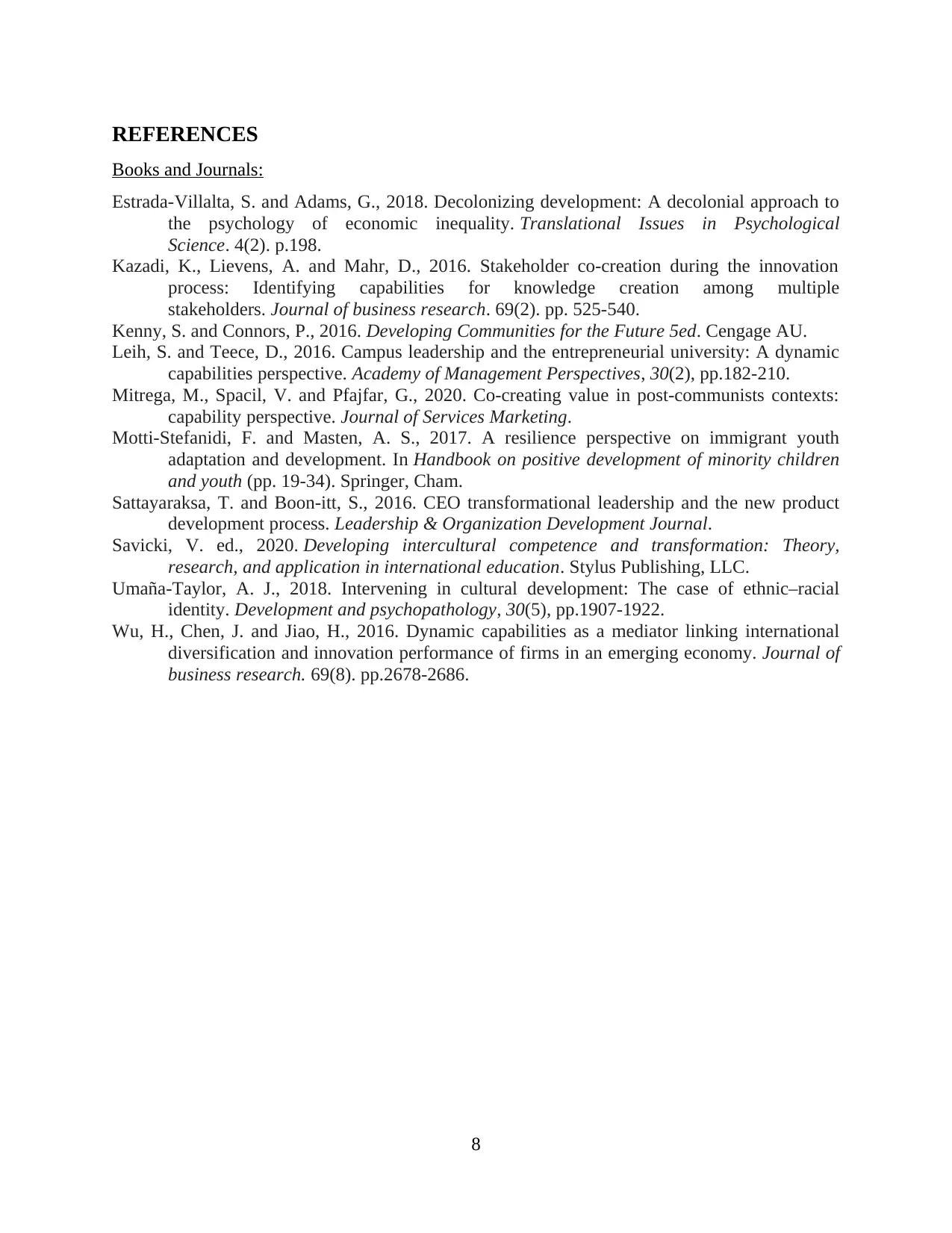
REFERENCES
Books and Journals:
Estrada-Villalta, S. and Adams, G., 2018. Decolonizing development: A decolonial approach to
the psychology of economic inequality. Translational Issues in Psychological
Science. 4(2). p.198.
Kazadi, K., Lievens, A. and Mahr, D., 2016. Stakeholder co-creation during the innovation
process: Identifying capabilities for knowledge creation among multiple
stakeholders. Journal of business research. 69(2). pp. 525-540.
Kenny, S. and Connors, P., 2016. Developing Communities for the Future 5ed. Cengage AU.
Leih, S. and Teece, D., 2016. Campus leadership and the entrepreneurial university: A dynamic
capabilities perspective. Academy of Management Perspectives, 30(2), pp.182-210.
Mitrega, M., Spacil, V. and Pfajfar, G., 2020. Co-creating value in post-communists contexts:
capability perspective. Journal of Services Marketing.
Motti-Stefanidi, F. and Masten, A. S., 2017. A resilience perspective on immigrant youth
adaptation and development. In Handbook on positive development of minority children
and youth (pp. 19-34). Springer, Cham.
Sattayaraksa, T. and Boon-itt, S., 2016. CEO transformational leadership and the new product
development process. Leadership & Organization Development Journal.
Savicki, V. ed., 2020. Developing intercultural competence and transformation: Theory,
research, and application in international education. Stylus Publishing, LLC.
Umaña-Taylor, A. J., 2018. Intervening in cultural development: The case of ethnic–racial
identity. Development and psychopathology, 30(5), pp.1907-1922.
Wu, H., Chen, J. and Jiao, H., 2016. Dynamic capabilities as a mediator linking international
diversification and innovation performance of firms in an emerging economy. Journal of
business research. 69(8). pp.2678-2686.
8
Books and Journals:
Estrada-Villalta, S. and Adams, G., 2018. Decolonizing development: A decolonial approach to
the psychology of economic inequality. Translational Issues in Psychological
Science. 4(2). p.198.
Kazadi, K., Lievens, A. and Mahr, D., 2016. Stakeholder co-creation during the innovation
process: Identifying capabilities for knowledge creation among multiple
stakeholders. Journal of business research. 69(2). pp. 525-540.
Kenny, S. and Connors, P., 2016. Developing Communities for the Future 5ed. Cengage AU.
Leih, S. and Teece, D., 2016. Campus leadership and the entrepreneurial university: A dynamic
capabilities perspective. Academy of Management Perspectives, 30(2), pp.182-210.
Mitrega, M., Spacil, V. and Pfajfar, G., 2020. Co-creating value in post-communists contexts:
capability perspective. Journal of Services Marketing.
Motti-Stefanidi, F. and Masten, A. S., 2017. A resilience perspective on immigrant youth
adaptation and development. In Handbook on positive development of minority children
and youth (pp. 19-34). Springer, Cham.
Sattayaraksa, T. and Boon-itt, S., 2016. CEO transformational leadership and the new product
development process. Leadership & Organization Development Journal.
Savicki, V. ed., 2020. Developing intercultural competence and transformation: Theory,
research, and application in international education. Stylus Publishing, LLC.
Umaña-Taylor, A. J., 2018. Intervening in cultural development: The case of ethnic–racial
identity. Development and psychopathology, 30(5), pp.1907-1922.
Wu, H., Chen, J. and Jiao, H., 2016. Dynamic capabilities as a mediator linking international
diversification and innovation performance of firms in an emerging economy. Journal of
business research. 69(8). pp.2678-2686.
8
1 out of 11
Related Documents
Your All-in-One AI-Powered Toolkit for Academic Success.
+13062052269
info@desklib.com
Available 24*7 on WhatsApp / Email
![[object Object]](/_next/static/media/star-bottom.7253800d.svg)
Unlock your academic potential
Copyright © 2020–2025 A2Z Services. All Rights Reserved. Developed and managed by ZUCOL.





